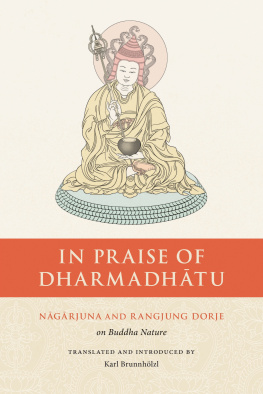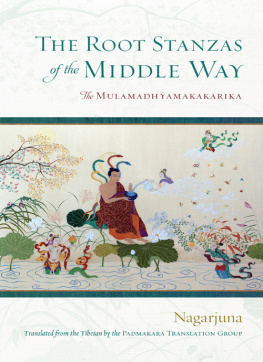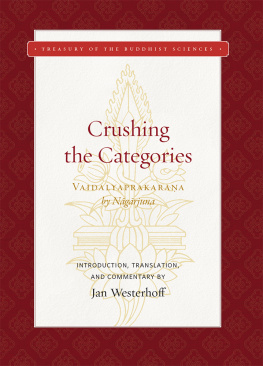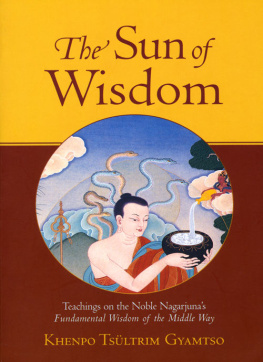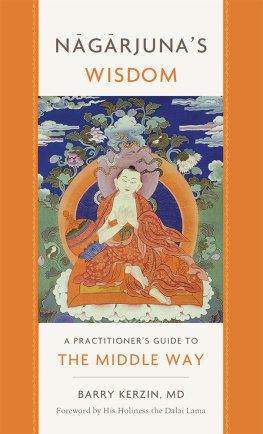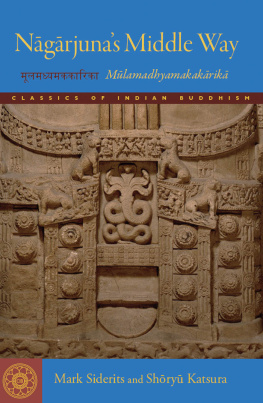Ngrjuna in Context
Ngrjuna in Context

Mahyna Buddhism and Early Indian Culture

Joseph Walser

COLUMBIA UNIVERSITY PRESS
NEW YORK

COLUMBIA UNIVERSITY PRESS
Publishers Since 1893
New York Chichester, West Sussex
cup.columbia.edu
Copyright 2005 Columbia University Press
All rights reserved
E-ISBN 978-0-231-50623-6
Library of Congress Cataloging-in-Publication Data
Walser, Joseph.
Ngrjuna in context: Mahyna Buddhism and early Indian culture / Joseph Walser.
p. cm.
Includes bibliographical references.
ISBN 0-231-13164-X (cloth : alk. paper)
1. Ngrjuna, 2nd cent. 2. Mdhyamika (Buddhism)
3. Mahyna Buddhism. I. Title.
BQ7479.8.N347w35 2004
294.392dc22
2004059350
A Columbia University Press E-book.
CUP would be pleased to hear about your reading experience with this e-book at .
For my father, Joseph Walser III,
for teaching me a love of learning

Contents
T HE PROCESS OF WRITING this book has been rather long and often difficult, and I could not have done it without the help of both friends and family. First and foremost, I am enormously grateful to my wife, Radha Subramanyam, who was a constant source of advice and inspiration for this book. Radha has provided emotional support while never compromising on her standards of what constitutes good scholarship. Her critical and scholarly eye was invaluable to the final product, one that I would never have begun it, let alone finished, without her. I also thank my family on both sides of the ocean for their help throughout my studies and through the crafting of this work. Their love and assistance over the years has been a large factor in the completion of the project.
In addition, I am grateful for the generous efforts of those scholars who read and commented on drafts of the book. In this category, especial acknowledgment is due to Jim Egge, who must have read four different drafts (without complaint!). I also thank Aloka Parasher Sen of University of Hyderabad, for her astute and extensive comments on the sections dealing with archaeology and early Indian history. Leonard Priestley agreed to read and comment on several drafts of the last two chapters. His expertise in the rather difficult Pudgalavdin material was a godsend. Furthermore, his keen eye for both philological accuracy and philosophical nuance in some instances forced me to completely rethink my approach.
I also appreciate the assistance of many other people who proofread drafts. I am especially grateful to Lydia Francis, who spent hours with me checking my translations from the Chinese. I also extend my gratitude to Wendy Lochner at Columbia University Press, who guided the book through the long journey to publication. I would also like to thank Debra E. Soled, who did an excellent job of editing the final draft as well as to the anonymous readers for Columbia University Press and Oxford University Press, whose comments were invaluable. I further acknowledge Ananda Abeysekhara, Gary Leupp, Ikumi Kaminishi, and Jim Ennis for their help and comments on specific chapters, and Parimal Patil, George Bond, Todd Lewis and Beth Burton for being generally supportive throughout the process.
Finally, I offer my appreciation for those professors who have mentored me over the years. Although there are too many to name all of them, three deserve special mention. I am eternally grateful to Adolf von Wuertenburg for sharing with me his love of Sanskrit, to David S. Pacini who, in his own way, opened my eyes to the joys of scholarship, and to Isshi Yamada, who showed me by his example what is possible. I sincerely hope that this book lives up to the standards they have set.


T HIS BOOK IS A STUDY of Ngrjuna, a Buddhist philosopher of the second century and a key figure in the development of Mahyna Buddhism in ancient India. Few figures in the history of Buddhism stand out more prominently than Ngrjuna. In Mahyna hagiographies, Ngrjuna is among the earliest of the great saints mentioned. Ngrjuna is prominently represented in the transmission lineages for both the Zen tradition and the various Tantric traditions. He has been cited as a source of authority by personages as diverse as Tsongkhapa in Tibet and Dgen and Shinran in Japan. As a measure of his authority, in the eighth century the Tibetan king Khri Srong lDe brTsan declared, Everyone should follow the teachings of Ngrjuna and engage assiduously in the practice of morality and the perfections.
To find someone of comparable stature in other religions, one would have to look to Augustine of Hippo or, perhaps, to Moses Maimonides. Yet such a comparison with Augustine and Maimonides would soon expose a serious deficiency in our knowledge about Ngrjuna. Scholars of Augustine, for example, have not only examined his arguments against Pelagius but also have investigated his institutional role as the bishop of Hippo. Similarly, scholars of Maimonides study his Thirteen Articles of Faith and Guide for the Perplexed but also examine and debate his other roles as a chief justice (dayyan) and as the physician to Saladin. Indeed, it has become common in scholarship of Western religious figures not merely to study the ideas of the author but to look at what those ideas meant in the social and institutional context in which the author wrote.
By contrast, despite great scholarly interest concerning Ngrjunas contributions to Mahyna doctrine, a similar level of interest in his social and institutional contexts has been absent. This absence is particularly unfortunate in light of the fact that Ngrjuna, along with Avaghoa, is one of the earliest-known figures in Mahyna Buddhism. Any study, therefore, that successfully uncovers his indebtedness to his contemporaries as well as his contributions to the larger Mahyna movement would also reveal a great deal about Mahyna Buddhism at a time when its doctrinal and institutional boundaries were being negotiated.
This book aims to achieve such a recovery. The traditional focus of Ngrjuna studies here shifts from viewing him as a philosopher to viewing him as an early champion of the nascent Mahyna movement. This shift draws the focus away from strictly doctrinal concerns and the logical viability of his arguments to questions of the imprint of social and institutional forces on his works. The center of the work, then, is not so much Ngrjunas teaching on emptiness but the rather strange way that he goes about arguing for it.
Ngrjuna is perhaps best known in the West for his employment of apparently logical arguments to arrive at counterintuitive conclusions. For example, the first verse of the first chapter of his Mlamadhyamakakrik posits, At nowhere and at no time can entities ever exist by originating out of themselves, from others, from both (self-other), or from lack of causes. My investigation of Ngrjuna is less concerned with the validity of these arguments than with the question: Why this particular argument and not some other?
Next page

